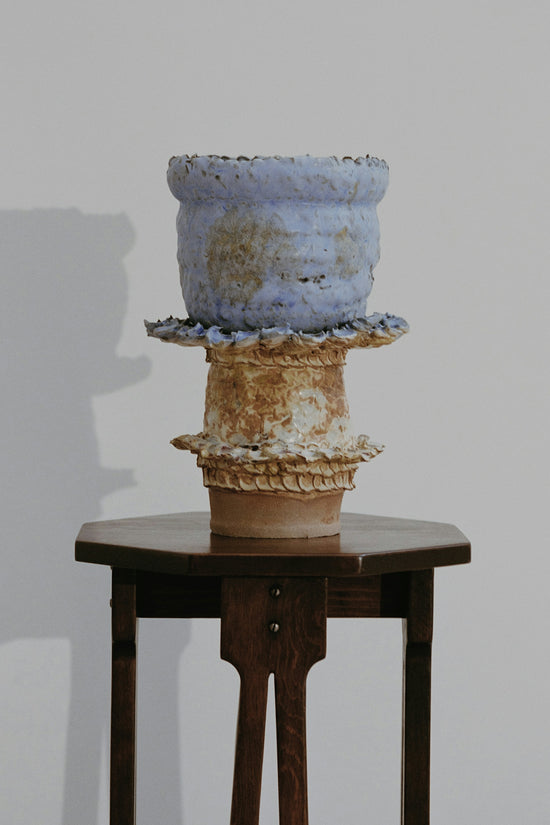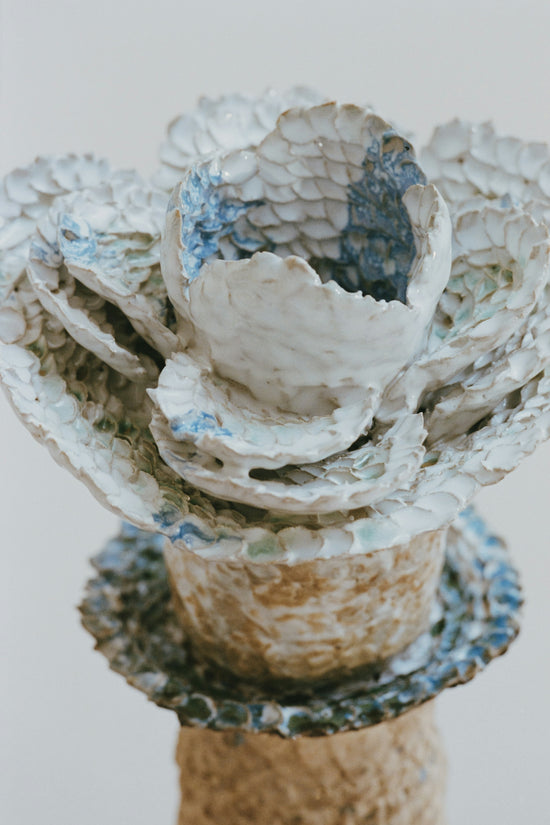Interview
Jennefer Hoffmann
EB: Where are you and how are you doing?
JH: I'm in Chicago and I am doing great, I just got back from New York.
EB: How has your language with your chosen material evolved over the years?
JH: As someone working in clay that didn’t go to art school, my relationship to it developed once I left New York. I began on the wheel and quickly started hand building from there. I work quite quickly when I make things and realized that clay can be a slow process where there’s waiting periods. In the beginning, I was just anxious to make what I wanted to make. I discovered that pinching pieces of wet clay allowed me to work quicker and build my forms higher. So essentially, in the beginning, my relationship to the material was defined by speed.
When I was pinching, I started to work in a kind of meditation like reaching a place of flow with the process. I was thinking about community. I was looking around at the lake and the buildings and the pinches started to become individuals in a way. The pieces were bigger than myself and I liked that sort of symbolism of what the many pinches could represent. They became whatever story or whatever thing I was thinking about in terms of what was going on in the world. I felt like I was making something that was about more people than more than just myself. This process of pinching became my primary language over the years.
In terms of the actual process, I start with a slab, always a slab. Then I pull pieces from that. It’s quite uniform as I’m simply taking pieces of clay very methodically and pinching them together. Sometimes I vary the direction of the pinch to create motion.

EB: Is there a particular milestone or moment in your life that feels really important in where you and the work are at now?
JH: I think there are a few important moments and one milestone. One moment is the day I left New York City. I was immersed in the art and fashion worlds in the city and was surrounded by friends making work. However, the city consumed me and I was not able to truly focus on my own practice. Another moment was taking a clay class when I first arrived in Chicago. This emerged out of a long time interest in wanting to throw clay. I often say that moving to Chicago gave me the space to develop an art practice. I suppose it had less noise and distraction than other places I lived.
Another moment was my second show at Volume Gallery in Chicago in 2021. I was going through something very difficult emotionally and the only thing I ended up able to do was to wrap clay around my little finger. The surprising thing was that the constraint of being very down led to an openness in my practice that I had always wanted to get to. I wanted it to be bigger than a vessel. It allowed me to write a poem in clay, to make the show an installation rather than a presentation of separate pieces.
And I think the milestone came the following year when I was accepted into three residencies after never having received one before. My work is often about what is going on inside me or where I am physically and the residencies gave me a challenge. I did not want to just make work about my emotional state as that was becoming unsustainable and quite exhausting. I started to look around and give myself some parameters.
The emotional was always going to be there so I started to tackle questions outside of me. In Columbus, Indiana I began looking at Saarinen Churches and started thinking about how I could visit these ideas within my forms. I think the residency experiences pushed me out of my comfort zone and this moved my practice forward once more.
EB: Sometimes responding to a new external world can be a powerful and unexpected way of evolving as an artist.
JH: During these residencies I was by myself a lot. I went from Columbus, Indiana, a place with rigid architecture to the rural Tennessee Mountains, where all I could hear was the buzzing of mud dauber bees. The steeple forms that I was starting to build in Columbus started to turn into the conical shapes that bees make.
EB: How does your practice relate to journaling and meditation?
JH: I don’t journal regularly, but I ruminate regularly! So maybe rather than on the page, I journal in my head about things. I do regularly write a thought or a word down and actually have just begun to write every morning. I don’t meditate in the traditional sense, but the inherent repetition in the work has become a form of meditation. It’s an outlet. I would compare it to running. In moments of running, or cold water swimming, you can reach a place of being completely present.

EB: I love how you title your work. To me they signify a repetitive, ongoing practice, but also create a mental, poetic space to float into and around. How do you relate to titling your work?
JH: It is a pleasure to come up with titles as well as finding comfort in the decision to not need to force one. At some point, I’d love to write more and it’s a way to do a little bit of that. Certain pieces don’t get titles, but the date pieces came when I decided to title a show the date of that show. Each piece in that show was so enormously personal that I felt that the best way that I could document it was by naming them with the day that they were made. I don’t like to imply too much in how I name them, because there should be something for the viewer to figure out themselves. There’s a piece that I titled “owl” and it was really just because it looked like an owl.
There are also funny things like “royal jelly”, which in that case came from the influence of the bees in Tennessee, but also how the piece looks like something like royalty.
Some of it is a humorous take on what it looks like and sometimes it can relate to what’s going on around me. And then there’s things that are painfully honest: “Where I ache” and “I cried for one year, two weeks and nine days.” Those are painfully honest titles made for a painfully honest show, which was made in such a moment of depression that I feel like I owed it to the show to be that honest. The “Things to…” titles came after the pieces were made. They do allude to a state of mind, to something one might want, or something that one wants to leave behind. The language is personal however, yet abstract enough to evoke one’s own relatable experience in a way.
EB: What will you be showing for A Room is an Archive of Touch?
JH: There will be a mixture of pieces, some that I’ve shown previously and others I haven’t. For example, there's a piece called “River”, which is a ceramic sculpture of a scarf thrown on the floor. “Where I ache” is in the show, which is nice, because a lot of people did not see that show because it was during Covid. I think a nice way of moving forward from the original loss felt within this presentation is to see these pieces outside of their original story. After all, Jacqueline’s place is also a poem of conversation between objects. There’s also a few of the “Things to…” pieces, which is a body of work that I'm still working on. I’ll also be showing a few pieces from another body of work that I haven’t nearly completed called “flowers for my mother”.
EB: It’s important to value what we’ve already made, how existing work can be represented, and recontextualized to find new neighbors and live a different life, especially in the context of Jacqueline’s space which is so unique and unapologetically itself. How are you thinking about the work as it communicates outwards to an audience?
JH: I don’t listen to Rick Rubin, but when I was just in New York, I was talking to a friend, and she was talking about how much she loved this one interview of his. Then on my way home, I stumbled into this clip of Rick and what I liked about what he said is that it isn’t your job to decide what the artwork’s role is once it leaves your hands. In fact doing so can compromise the work you’re meant to do. I like this idea in the context of my return to New York after so long to show work in a city that is very meaningful to me. I also like this idea of the open object where different people can come to a piece of work and feel a certain thing. Maybe at a certain time I would have loved it if someone felt a specific thing, but maybe now that I’m a bit older, I don’t know if a viewer has to feel anything at all. Or maybe someone connects to the title and not the piece. I don’t mind that at all.
EB: One of the first things you said in our conversation was that leaving New York helped give you encouragement to start making your own work. How does it feel to return as an artist?
JH: Whenever I go back to New York, it always feels like home to me. I spend a lot of time walking and not enough time being in my home. And that's probably a huge reason why I didn't make enough art. It feels good to come back for this occasion because I finally did what I always wanted to do while I was there.
EB: What feels particularly important to you as an artist and human right now?
JH: I’m very grateful. I often struggle with the ‘why’ in terms of why making art is important. It can feel very privileged to me. I think kindness is also important. It's good to step outside one's own narrative for a moment, to feel and see other possibilities, to move things forward and to continually be open to learning. It’s actually very specific to my work at the moment, but I think it also speaks to what’s happening in the world as well.






